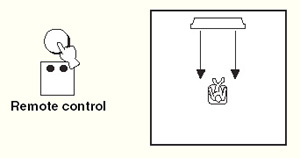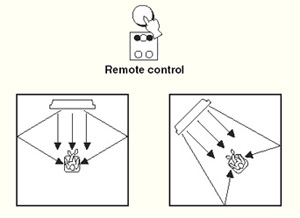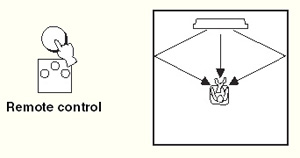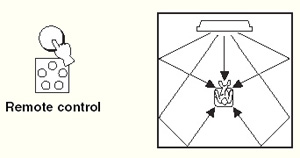Set-up
The YSP-1 provides three set-up options. The first option contains three
preset listening room types. The user simply has to select one of these
three options based on the size of their room. The second option is a wizard
driven process called Easy Set-up. The user is asked a series of multiple
choice questions. The third set-up option is for the user to manually set up
all the YSP-1 parameters. Set-up can be done using the single line YSP-1
display, although exercising the OSD (connecting the composite video output
of the YSP-1 to your TV) functionality makes GUI navigation
easier. I recommend skipping the preset configurations in favor of the other
two set-up options. If you use the easy method and feel that you cannot
specify your listening configuration adequately, use the Manual setup.
 The
manual set-up menu is quite extensive, and it does give you fine control over
several parameters. The set of parameters that are most relevant to
controlling the location of the virtual speakers are grouped under the
Beam menu. Both the horizontal and vertical beam angles (variable between
-900 to +900 in 50 increments) can be adjusted
independently for all the speakers. A test tone is automatically generated
as you adjust these angles. The test tone is extremely useful in positioning
the virtual speakers. In addition to adjusting the angles, one can specify
the YSP-1 location (corner, center, etc.) and its distance from the
floor/left wall/listener. Much like a conventional SSP, the YSP-1 time
aligns these speakers using the distance each beam travels to the listener.
This distance, if incorrect, can be manually altered in 0.5 ft increments.
The
manual set-up menu is quite extensive, and it does give you fine control over
several parameters. The set of parameters that are most relevant to
controlling the location of the virtual speakers are grouped under the
Beam menu. Both the horizontal and vertical beam angles (variable between
-900 to +900 in 50 increments) can be adjusted
independently for all the speakers. A test tone is automatically generated
as you adjust these angles. The test tone is extremely useful in positioning
the virtual speakers. In addition to adjusting the angles, one can specify
the YSP-1 location (corner, center, etc.) and its distance from the
floor/left wall/listener. Much like a conventional SSP, the YSP-1 time
aligns these speakers using the distance each beam travels to the listener.
This distance, if incorrect, can be manually altered in 0.5 ft increments.
 As
has been mentioned previously, the front left/right virtual speakers are
positioned at the reflection points on the side-walls. This is where the
listener perceives the sound for these speakers to emanate from. If you are
in a relatively large room, or the size of the television is small compared
to the width of the room, the soundstage across the front might be too wide.
If the listener/speaker distances are not equidistant from the side-walls, one speaker
would be closer than the other. In both cases the presentation would sound
unnatural. The YSP-1 provides a clever control to move the image towards the
center speaker. This is done by mixing a specified amount of the signal
(adjustable between 0%-95% in 5% increments) from the respective channel to
the center speaker. The mixing amount can be set independently for the left
and right speakers.
As
has been mentioned previously, the front left/right virtual speakers are
positioned at the reflection points on the side-walls. This is where the
listener perceives the sound for these speakers to emanate from. If you are
in a relatively large room, or the size of the television is small compared
to the width of the room, the soundstage across the front might be too wide.
If the listener/speaker distances are not equidistant from the side-walls, one speaker
would be closer than the other. In both cases the presentation would sound
unnatural. The YSP-1 provides a clever control to move the image towards the
center speaker. This is done by mixing a specified amount of the signal
(adjustable between 0%-95% in 5% increments) from the respective channel to
the center speaker. The mixing amount can be set independently for the left
and right speakers.
 A
Room EQ option is provided with three fixed settings: Standard, Live, and
Wall Mount. The manual mentions room reflectivity in association with the
first two controls. I am guessing that the first option leaves the treble
untouched, while the second option attenuates it. The Live option was very
useful in taming the high frequencies when I heard the YSP-1 in rooms with
bare walls. I did at times wish for an option that was perhaps a little less
aggressive. The third option probably applies an upper-bass/lower-midrange
attenuation filter to compensate for boundary coupling when the speaker is
wall-mounted. Only one option can be selected, so if you have your speaker
wall mounted and have a live room, you have to decide which EQ option to
use. It would have been nicer to group these in different categories and to
add further controls for different placements. What would perhaps be even
better would be incorporate Yamaha’s automatic room EQ (YPAO) system. For
the market that this product is targeted at, some kind of auto-setup will be
very useful.
A
Room EQ option is provided with three fixed settings: Standard, Live, and
Wall Mount. The manual mentions room reflectivity in association with the
first two controls. I am guessing that the first option leaves the treble
untouched, while the second option attenuates it. The Live option was very
useful in taming the high frequencies when I heard the YSP-1 in rooms with
bare walls. I did at times wish for an option that was perhaps a little less
aggressive. The third option probably applies an upper-bass/lower-midrange
attenuation filter to compensate for boundary coupling when the speaker is
wall-mounted. Only one option can be selected, so if you have your speaker
wall mounted and have a live room, you have to decide which EQ option to
use. It would have been nicer to group these in different categories and to
add further controls for different placements. What would perhaps be even
better would be incorporate Yamaha’s automatic room EQ (YPAO) system. For
the market that this product is targeted at, some kind of auto-setup will be
very useful.
 Listening
Listening
The first time I set up the YSP-1, was in my bedroom which is a small sized
room with a narrow hall in the front left of the room leading to a door. The
back and side walls are bare. I don’t spend much time listening to music or
watching movies in my bedroom, but I chose it primarily because in my house
I thought that this location would be best suited for the YSP-1.
To get started, I used the Easy Set-up method, and within a few minutes I
was ready to go. The first DVD to go in was Avia Pro, and I played the
channel identification track to see how the voice and test tone would move
from speaker to speaker. For the front L/C/R speakers, the voice moved
across the front of the room with the test tone; however, for the surround
speakers, the voice kind of came from the front while the test tone appeared
to originate from a location on the side wall that was slightly in front of
me. So why could I not get the feeling that the surround speakers were
behind me? Two aspects probably resulted in this not being the case. First
of all, I was seated pretty close to the back wall. Secondly, the Easy Set-up was less than ideal. I was hearing the side wall reflection directly,
which meant that the horizontal beam angle was not quite right.
So, I moved away from the back wall and started to fiddle with the beam
settings in Manual mode. Tweaking the settings manually resulted in a big
improvement. Replaying the channel identification track this time around, I
could hear the test tone for the surrounds coming mostly from my side with a
faint sound coming from behind my back. The voice, however, always appeared
to come from the front. This was the best I was able to achieve. Moving on
to the pink-noise pan, the steering from speaker to speaker was not as
smooth as what one would get with five discrete speakers, but the sound
definitely moved around the room.
On actual material, the YSP-1 performed better. While watching American
Beauty, there was one scene where my wife and I looked at each other
and said, "That was cool". The reference here was not to the movie, but to a
particular sound effect. In chapter 7, Ricky walks into the room while his
parents are watching a movie. You can hear the door open to the right and
then hear his footsteps as he walks across the room. The front virtual
speakers sounded very real. The part that was a bit distracting however, was
the width of the front soundstage. The sound panned from the right wall to
the center of the speaker, which works well with a wide screen where there
is only a short space between the screen and the side walls. Since I was
using a smaller television, I found the menu items to move the virtual
speakers closer to the side of the television to be very useful.
Next up was the "The Echo Game", chapter in The House of Flying Daggers.
Towards the end of the scene, I can hear the jingling of beads. There was
definitely a very good sense of envelopment here, and I could briefly hear
some sound coming from behind me as well.
In terms of its sonic performance, taking into account the fact that all the
sound was coming from a single enclosure, I would say that the YSP-1
performed quite well. Midrange reproduction was good, but what was missing here
was the smoothness and fullness, particularly on male voices, that I am
accustomed to hearing. The treble was crisp, with a slight hint of
brightness when there was a fair bit of activity with the surround channels.
I was able to cure the brightness through the acoustic controls available on
the YSP-1.
While watching movies, the 5 Beam Mode was my favorite amongst the
different options. When listening to music, however, I found myself
switching between the 5 Beam Mode” and the Stereo+3 Beam Mode. The former
mode sounded more spacious, while the latter mode produced a slightly better
focused front soundstage.
I also tried the YSP-1 in my dedicated room which is rectangular in shape.
The only opening is through a door in the rear corner. There is plenty of
absorptive acoustical treatment on the walls. The experience in this room
was not as positive as it was in the bedroom with reflective walls. This is
to be expected given that the YSP-1 needs reflective walls to bounce sound
off of. In fact the manual does have a section talking about its limited
effectiveness is such rooms.
Other spaces that are not ideal for the YSP-1 include rooms with large
openings on one or more sides. Although my living room is like this, I set up
the YSP-1 in there briefly just to see the effect. Of the various beam
modes, the Stereo+3 Beam Mode was the one mode that worked well for the
front L/C/R channels, but due to the asymmetry (large opening on one side), the
effectiveness of the surround channels was diminished. No surprise here. The
bottom line is that to maximize the YSP-1's potential, it must be installed
in an environment that complements it.
Conclusions
With the YSP-1, Yamaha has drawn upon their extensive experience in digital
signal processing to offer a unique surround sound solution. Its slim
profile and simple yet stylish look will be a good match for flat-panel
displays. Hook-up is easy, and there are few wires to run. All this should
translate into a product with a high spouse acceptance factor.
When it comes to performance, the YSP-1 works respectably well. The
envelopment, of course, is not as convincing as what one can get from a
conventional discrete speaker installation, but the YSP-1 could be the next best thing if you cannot accommodate a
conventional setup. My
only word of caution here has to do with the environment that the YSP-1 is
placed in. You must have reflective surfaces for it to work or else you will
be limiting its effectiveness. An in-home audition of this product is highly
recommended unless you can hear it in an environment that is similar to
yours. Once it is installed in a proper room, however, you might be
surprised at the surround sound you are getting from places where there are
no speakers.
- Sumit Chawla -